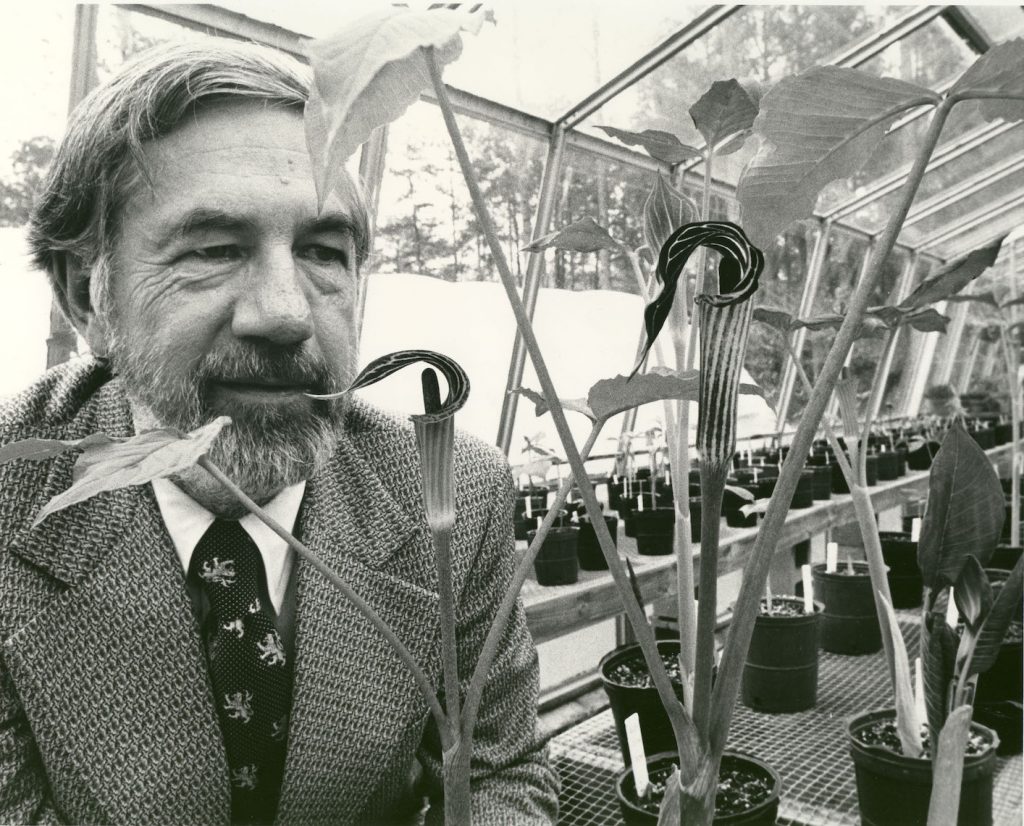The North Carolina Botanical Garden has lost one of its most ardent and long-lived friends, Dr. C. Ritchie Bell. An active and influential scientist, Bell enthusiastically advanced the appreciation and conservation of native plants, especially in the southeastern United States.
Ritchie Bell led the effort in the early 1960s to establish the North Carolina Botanical Garden, which officially opened with the dedication of the first nature trail on April 10, 1966. Bell was was appointed to the directorship in 1961, in which he served until 1986. In that time, he took a tract of 72 acres on the southern edge of the campus of the University of North Carolina at Chapel Hill and turned it into one of the most active public gardens in the Southeast. He and his staff pioneered the Garden’s mission—one that at the time was unique in the botanical garden world: conservation-focused gardening.
Bell received his AB in 1947 (Class of 1945) and his MA in Botany in 1949 at the University of North Carolina at Chapel hill, and his PhD in Botany at UC-Berkeley in 1953. After teaching for two years at the University of Illinois, he returned to UNC-CH in 1955, as an assistant professor in botany, where he remained until his retirement from teaching in 1991.
At the University of North Carolina, Ritchie Bell followed in the tradition of William C. Coker, the university’s first professor of botany, and was instrumental in making this the premier southern university for the study of botany. The expression of that work was the publication, with coauthors Albert E. Radford and Harry E. Ahles, of the monumental Manual of the Vascular Flora of the Carolinas (1964, the University of North Carolina Press)—the fundamental reference work for this region of the Southeast for 40 years. The atlas of plant distribution that was included in that manual showed the distribution of some 4,000 taxa of plants across all 100 counties of the state of North Carolina (as well as the counties of South Carolina) and demonstrated how the work of botanists at the university and elsewhere is vital to the state. The research behind this volume—and continuing today through the UNC Herbarium and botanists in a number of state agencies and universities—is at the foundation of our understanding of endangered species, detection of new weeds, development of trees and wildflowers for the horticultural industries, identification of medicinal and poison plants, propagation of plants for ecological restoration, and more.
Ritchie Bell may be best known among North Carolinians for his popular book, Wild Flowers of North Carolina, (coauthored with William S. Justice) first published by the UNC Press in 1968 and then reissued by the press in a second edition in 2005 (coauthored with his wife, Dr. Anne H. Lindsey, also an accomplished botanist). He also co-authored Florida Wild Flowers and Roadside Plants (1980), Fall Color and Woodland Harvests of the Eastern Forests (1990), and Fall Color Finder (1991) published by Laurel Hill Press.
Bell’s leadership in the conservation arena was considerable. Critically important was his work in drafting the legislation that created, in 1979, the North Carolina Plant Conservation Program, which gave legal protection to the state’s rarest plant species. The National Council of Garden Clubs recognized his contributions to conservation with the Sliver Seal Award in 1979. He also received the Wherry Award of the American Rock Garden Society in 1984. And during his term as director of the North Carolina Botanical Garden, Bell received the Gulf Oil Conservation Award for “exceptional service in the cause of conservation” because of accomplishments in a wide range of projects. In 2006 he received the The Botanical Society of America’s Centennial Award, which acknowledges and honors outstanding service to the plant sciences and the Society. In 2007, he received the Distinguished Alumnus Award from the University of North Carolina at Chapel Hill.
In retirement, Ritchie Bell continued to support the mission of the North Carolina Botanical Garden. He was passionate about its expansion to include a green building and new gardens, telling the crowd gathered at the October 2009 dedication of the Education Center that it was a great day indeed. “His enthusiasm was remarkable and memorable, and he will not be forgotten by those he inspired, in the classroom, in the lecture hall, and in the field” (Dr. Peter White, Director, at the 2007 Distinguished Alumnus Award ceremony).
“During his directorship, Ritchie, working with the early staff, created the identity and spirit of the North Carolina Botanical Garden, which grew rapidly to a place of prominence among southeastern institutions and within the larger community of botanical gardens. It has been a pleasure for those of us who came later to keep that distinctive spirit alive and to nurture the unfolding of the Garden so that it would stay true to the values that were so clearly demonstrated at the beginning: an unshakable belief in the glory of wildflowers and a recognition of North Carolina and the Southeast as a remarkable corner of the plant kingdom. We have continued to try to foster the joy of learning about nature, to emphasize the importance of conservation for wild diversity and for human quality of life, and to encourage everyone to become wise stewards of natural resources. Ever since Ritchie, it’s been a garden about biological diversity and the essential connection of human life to the quality of the environment around us.” —Dr. Peter White, director NCBG, 2013
